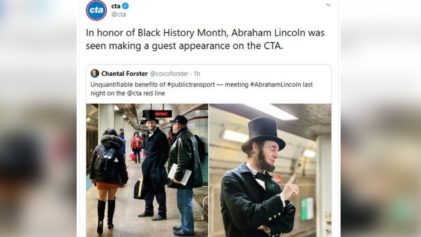
FILE – This July 14, 2017 file photo, shows two of the 40 statues titled “Children of Whitney” by Woodrow Nash, in front of one of the slave cabins at the Whitney Plantation museum in Edgard, La. Owner John Cummings, an attorney and real estate investor, opened the site as a slavery museum, bucking a tradition of plantation tours that romanticize antebellum life and gloss over the slave trade. (AP Photo/Gerald Herbert)
Black History Month is an annual opportunity to reflect on the significant contributions that people of African descent have made to American culture and history. In February, children of all races are encouraged to learn about the Black writers, musicians, inventors, entrepreneurs, and freedom fighters who toiled to make life in this nation more tolerable for their descendants.
While it may seem that learning about the inventors of the gas mask or the home security system is just a way for teachers to pad their lesson plans, learning Black history has positive effects for those that learn it — both inside and outside of the classroom. One study found that African-American children in Cleveland who participated in programs highlighting African-American literature and themes had increased “cognitive abilities, reading readiness, and achievement-oriented skills.” Significantly, the study also found that these students had higher self-esteem. The benefits are not limited to children of African descent. Researchers from the University of Texas and SUNY-Stony Brook found “learning about racism is beneficial among European American children because it promotes more positive — and less negative — views of African-Americans.”
Though the study of Black history clearly benefits both Black children and children of other races, what is less clear is whether those responsible for teaching the subject are doing a good job of it.
Although slavery is a key component of Black history, schools struggle to teach it well. Teaching Hard History, a 2018 report from the Southern Poverty Law Center (SPLC), indicates that many American schools fail to teach slavery in an accurate or adequate manner. The authors of the report reviewed textbooks and state standards to determine if they taught the basics about slavery. Additionally, they surveyed teachers and students to determine what was taught and learned in classrooms. The results, to put it politely, are not encouraging.
The bright spot in the report is teachers. When asked, over 90 percent of teachers agreed that they felt comfortable teaching slavery. Significantly, 89 percent strongly agreed that teaching slavery is important to provide a full understanding of American history. While the teachers expressed great enthusiasm for the subject, they were less than thrilled with the tools at their disposal for teaching such a difficult subject. Only 15 percent of teachers strongly agreed that their states provided adequate support for teaching slavery. Even worse, only 8 percent of the educators strongly agreed that their textbooks did a good job of covering slavery.
The SPLC’s findings support the teachers’ beliefs. The report found that of the ten textbooks reviewed in the study, only two came close to properly covering slavery — and even those texts needed improvement. Moreover, states were widely inconsistent in their curriculum requirements for teaching the subject. Ten core concepts were put together by historian Ira Berlin in his forward to the book Understanding and Teaching American Slavery. These concepts were later used by Teaching Tolerance as the basis for thinking through the report. The ten concepts are below:
- Slavery, which predated European settlement, was important to all of the colonial powers and existed in all of the European North American colonies.
- Slavery and the slave trader were central to the development and growth of the economy across British North America and later, the United States.
- Protections for slavery were embedded in the founding documents; enslavers dominated the federal government, the U.S. Supreme Court, and the U.S. Senate from 1787 through 1860.
- “Slavery was an institution of power,” designed to create profit for the slaveholder and break the will of the enslaved and was a relentless quest for profit abetted by racism.
- Enslaved people resisted the efforts of their enslavers to reduce them to commodities in both revolutionary and everyday ways.
- The experience of slavery varied, depending on time, location, crop, labor performed, size of slaveholding, and gender.
- Slavery was the central cause of the Civil War.
- Slavery shaped the fundamental beliefs of Americans about race and whiteness and white supremacy was both a product of, and legacy of, slavery.
- Enslaved and free people of African descent had a profound impact on American culture, producing leaders, and literary, artistic, and folk traditions, etc., that continue to influence the nation.
- By knowing how to read and interpret the sources that tell the story of American slavery, we gain insight into some of what enslaving and enslaved Americans created, thought, aspired to, and desired.
Many states were not reviewed, but of the ones reviewed below reflects how many concepts are covered:
California: 8; Washington State: 1; New Mexico: 0; Oklahoma: 2; Kansas: 1; Louisiana: 1; Alabama: 3; Georgia: 5; Florida: 2; South Carolina: 2; North Carolina: 3; Virginia: 1; New; Jersey: 0; New York: 3
In light of these difficulties, the report’s finding that only eight percent of high school seniors could correctly note that slavery was the major cause of the Civil War is unsurprising.
Slavery is not the only Black history topic that schools struggle to teach. Teaching the Movement, a 2014 report of SPLC’s Teaching Tolerance program, examined how well schools teach the history of the civil rights movement. The report states, “We remain concerned that students are likely to remember only two names and four words about the civil rights movement: Martin Luther King Jr., Rosa Parks and “I have a dream.” The report graded all 50 states on their success in covering the civil rights movement. Only three states — South Carolina, Louisiana, and Georgia — earned an A. Eight states received a B, while six states warranted C scores. The remaining states — 33 of 50, or 66 percent — were given — D’s and F’s. These states were criticized for overlooking key concepts or omitting discussion of the civil rights movement entirely.
Changing the way Black history is taught in schools can be a difficult, multi-pronged process that takes years to bear fruit.
Parents and activists have organized to express their displeasure with the Black history offerings in their schools and the lack of support for Black students in general, but creating actual changes in the classroom curricula in those cities have been few and far between.
One group of parents achieved a major success in improving racial justice awareness in classrooms, something they are using as a first step toward improving Black history education. In October 2016, parents and teachers in Seattle organized a Black Lives Matter in Schools day to protest the cancellation of an event that was geared toward Black male youth. The protest grew into a movement that demanded, in part, “Support [for] ethnic studies in all schools.” Their efforts were supported by the local Black Lives Matter chapter as well as the local branch of the NAACP. Now, less than two years later, Black Lives Matter in Schools Day is celebrated annually in many cities across the nation. According to the Washington Post, the Black Lives Matter at School movement focuses on “institutional racism, black history and identity, and restorative justice.” Clearly, when parents and educators mobilize with community activists, they can create change on a local level — or even a national one.
The biggest impacts on Black history education often come at the state level, where decisions on the textbooks are made. California, after more than 10 years of wrestling with the topic of how to reflect the state’s multicultural history in classrooms, recently adopted sweeping changes to course materials used in its schools.
Based on these reports, it seems clear that merely teaching Black history is not enough. It must be taught well. Having proper support from districts and textbooks is critical to that process. But the next logical question is in light of the struggles they face when teaching the subject, are schools the best place to teach Black History? If schools struggle to teach Black history in an adequate fashion, some may argue that Black parents should take the initiative and pick up the slack.
Indeed, there are many benefits to teaching Black history in the home. A study by researchers from Mount Sinai School of Medicine found that Black parents’ attempts to teach history actually reduced anxiety in their children. Moreover, even where schools teach Black history, as mentioned, they may not cover all of the necessary topics. The 2017 Social Education report found that while teachers were generally enthusiastic about teaching Black history, most were able to devote less than ten percent of class time to the subject. Perhaps because of the limited time, the subjects covered are also limited. The report found that the four subjects most likely to be covered were slavery, Brown v. Board of Education, the Civil Rights Acts of the 1960s, and the election of Barack Obama. While these subjects should certainly be studied in school, Black history is a far more complex subject. Black parents may feel that studies at home can better cover the depth and richness of Black history better than limited school instruction.
Although children benefit from at-home instruction, some Black parents may feel reluctant to share vivid images or stories of some of the more graphic parts of Black history, such as the horrors of the Middle Passage, the cruelty of slavery, the brutality of lynching, and the like. To make it more difficult, there are few resources that provide guidance to African-American parents about how to introduce these difficult subjects. As a result, some Black parents may think it best to leave these subjects to those with educational expertise. While these feelings are understandable, Black parents may wish to push past any discomfort with the uglier side of our history to ensure that their children receive the academic and emotional benefits that Black history provides for Black children.
When Black history is taught well both at home and in school, Black children will receive the maximum impact on their academic success and emotional growth that knowledge about their rich, varied, and deep history provides.


